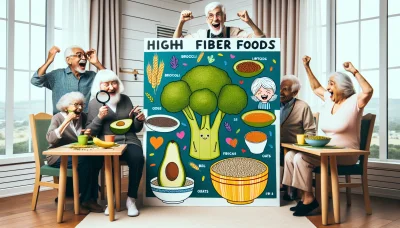Breakfast foods high in fiber Quiz
Test Your Knowledge
Question of
Understanding High-Fiber Breakfast Foods
Benefits of Fiber in Your Morning Routine
Kick-starting your day with a high-fiber breakfast can be a game-changer for your health. Fiber-packed meals contribute to feeling full longer, preventing those mid-morning cravings. It's not just about satisfaction; fiber is essential for maintaining a healthy digestive system, making it a cornerstone of any nutritious breakfast.
Fiber is a powerhouse when it comes to sustained energy. Unlike sugary cereals or pastries that spike your blood sugar levels, high-fiber foods release energy gradually. This means you stay alert and focused throughout the morningno more energy crashes before lunch!
When it comes to managing appetite and weight control, fiber is your ally. By slowing down digestion, it helps regulate blood sugar levels and keeps hunger at bay. Incorporating fiber into your breakfast routine can lead to better food choices throughout the day and contribute to a balanced diet.
Improved Digestive Health
A morning dose of fiber works wonders for your digestive tract. It aids in the smooth movement of food through your system, reducing the likelihood of constipation. A consistent intake of fiber can also help prevent various gastrointestinal issues and promote overall gut health.
Did you know that a high-fiber breakfast can also have long-term benefits? Regular consumption has been linked to a reduced risk of developing digestive system disorders, including certain types of cancer. Making fiber a staple in your morning meal is an investment in your digestive well-being!
Sustained Energy Levels
Imagine powering through your morning without any sluggish feelingsthat's what fiber can do for you! By stabilizing blood sugar levels, high-fiber foods ensure that you have a constant supply of energy. No more relying on caffeine to get you through the day!
Fiber's complex structure means that your body takes its time digesting it. This slow release mechanism provides you with enduring energy, helping you tackle tasks with vigor and vitality from morning till afternoon.
Appetite and Weight Control
Fiber's role in satiety is well-documentedit expands in your stomach, making you feel fuller for longer periods. This natural appetite suppressant can help curb overeating and snacking, which is crucial for weight management and overall health.
Maintaining a healthy weight doesn't have to be about strict diets; simply incorporating more fiber into your breakfast may naturally lead to consuming fewer calories throughout the day. Its a simple yet effective strategy for weight control.
Types of Dietary Fiber
Soluble Fiber Sources
Soluble fiber dissolves in water forming a gel-like substance that can lower cholesterol and glucose levels. Oats, apples, and beans are excellent sources of soluble fiber and perfect ingredients for an energizing breakfast.
Insoluble Fiber Sources
The roughage typeinsoluble fiberdoes not dissolve in water but adds bulk to waste in the digestive system, aiding bowel movements. Whole grains and many vegetables are packed with insoluble fiber, making them ideal choices for a hearty breakfast.
- Berries: Sprinkle them on oatmeal or yogurt for an antioxidant boost.
- Nuts and Seeds: Add crunch and nutrients to any breakfast bowl.
- Bran: A sprinkle on cereal or mixed into baked goods increases fiber content significantly.
- Legumes: Try spreading hummus on whole-grain toast for something different.
- Avocado: Rich in both soluble and insoluble fibers, avocados are versatile breakfast companions.
Prebiotic Fiber and Gut Health
Prebiotic fibers are specialized plant fibers that nourish the good bacteria in the gut. Foods like bananas, onions, and garlic contain prebiotic fibers which support gut health by enhancing the growth of beneficial bacteria.
Top High-Fiber Breakfast Options
Whole Grain Choices for Breakfast
Starting your day with whole grains can boost your fiber intake significantly. Whole grains like oats, quinoa, and whole wheat provide essential nutrients and help maintain digestive health. They're not only packed with fiber but are also a great source of energy to kickstart the morning!
Choosing whole grain options for breakfast is an easy way to keep you full longer and curb mid-morning cravings. Incorporating these into your first meal can support weight management and stabilize blood sugar levels, making them an excellent choice for a balanced diet.
Oatmeal and Its Variations
Oatmeal is a powerhouse breakfast option. It's versatile, easy to prepare, and can be flavored in countless ways. Whether you like it sweetened with honey and fruits or savory, topped with a poached egg and avocado, oatmeal is an incredible vehicle for both taste and nutrition.
The beauty of oatmeal lies in its variations overnight oats, steel-cut oats, or instant oatmeal offer different textures and convenience levels. Each type brings a hearty dose of fiber to the table, along with the opportunity to add nuts, seeds, or protein powders for an extra nutritional punch.
Quinoa-Based Breakfast Bowls
Quinoa isn't just for lunch or dinner; it's an excellent start to the day! This gluten-free pseudo-grain contains all nine essential amino acids making it a complete protein source. A quinoa breakfast bowl could be the change you need to revamp your morning routine.
Mix cooked quinoa with almond milk, nuts, fruits, or even a swirl of nut butter for a satisfying bowl. Its high-fiber content helps regulate digestion while providing sustained energy throughout the morning hours.
Whole Grain Toast Toppings
Whole grain toast offers more than just a crunchy base; it's an opportunity to get creative with toppings that increase your fiber intake. From classic peanut butter and banana slices to innovative spreads like hummus or tahini - each combination is a chance to enhance your fiber consumption.
Don't underestimate the power of seeds chia, flaxseeds, or pumpkin seeds on top can transform your toast into a high-fiber masterpiece. Experimenting with various toppings keeps breakfast exciting and nutritionally balanced.
High-Fiber Fruits to Start Your Day
Fruits are not only refreshing but are also brimming with vitamins, minerals, and importantly - dietary fiber. Including high-fiber fruits in your breakfast is an effortless way to contribute to your daily fiber goals while enjoying natural sweetness.
Fiber-rich fruits aid in digestion and can help prevent spikes in blood sugar when paired with other macronutrients like proteins or fats. They're also hydrating which is crucial after a long night's rest starting your day with fruits can boost overall health and vitality!
Berries and Citrus Fruits
Berries such as raspberries, strawberries, blueberries, and blackberries are fiber superstars that pack a punch in small servings. Their vibrant colors signify high antioxidant content which protects cells from damage. Citrus fruits like oranges and grapefruits provide soluble fibers that benefit heart health.
These fruits are perfect as standalone snacks or as part of larger meals like smoothies or yogurt parfaits. Their low-calorie profile combined with high fiber makes them ideal for anyone looking to maintain or lose weight while still enjoying delicious flavors.
Apples and Pears with Skin
An apple or pear a day could indeed keep the doctor away! Eating these fruits with their skin on maximizes their fiber content which promotes satiety and aids in maintaining regular bowel movements. They're convenient on-the-go snacks that require minimal preparation.
- Eat them fresh: The simplest way is just biting into one! No fuss pure goodness.
- Add them to cereals: Chopped apples or pears can add crunchiness to your morning cereal or oatmeal.
- Mix into batters: Grated apple or pear can moisten baked goods while adding fiber.
- Create compotes: Cooked down with spices they make delightful toppings for pancakes or waffles.
Avocado as a Fiber-Rich Fruit
The creamy texture of avocados hides their true nature as a fiber-rich fruit. Rich in both soluble and insoluble fibers, they help maintain gut health while providing heart-healthy fats. Avocado toast has become iconic not just for its taste but also for its health benefits.
Incorporating avocado into smoothies, salads, or simply slicing it as a side dish can increase the nutrient density of any meal. It's particularly beneficial for those who need more satisfying foods that support digestive health without compromising flavor.
Incorporating Fiber into Popular Diets
Fiber on a Low-Carb Diet
Integrating fiber into a low-carb diet is not only possible but also incredibly beneficial for digestive health and satiety. While traditional low-carb diets emphasize proteins and fats, it's crucial not to overlook the importance of fiber-rich vegetables and seeds. By choosing high-fiber, low-carb options, you can enjoy the benefits of both dietary approaches.
Many people mistakenly believe that a low-carb lifestyle means giving up on fiber, but this is far from the truth. With careful planning, you can select foods that are low in carbohydrates yet high in dietary fiber. This balance is essential for maintaining gut health while adhering to your carb restrictions.
High-Fiber Low-Carb Foods
When it comes to fibrous, low-carb foods, think beyond leafy greens. Avocados, chia seeds, and flaxseeds are powerhouses containing both soluble and insoluble fibers. Including these in your diet can significantly boost your fiber intake without adding too many carbs.
Nuts like almonds and walnuts not only add crunch to your meals but also contribute valuable fiber while keeping carbs in check. Berries such as blackberries and raspberries are another excellent choice for a sweet yet fibrous addition to a low-carb diet.
Balancing Macronutrients
Striking the right balance between macronutrients is key when incorporating fiber into a low-carb diet. A focus on lean proteins, healthy fats, and fiber-rich vegetables creates a well-rounded meal plan that supports weight management and overall health.
Remember that each individual's body responds differently to dietary changes. Monitoring how you feel with various levels of carb and fiber intake can help you fine-tune your diet for optimal results.
Creative Low-Carb Breakfast Ideas
- Mix chia seeds with almond milk overnight for a pudding-like breakfast full of fiber.
- Create an omelet packed with spinach, mushrooms, and bell peppers for a savory start to your day.
- Use coconut flour or almond flour as a base for pancakes or waffles to keep breakfast fun without the carbs overload.
- Top Greek yogurt with nuts and seeds for an easy, high-protein breakfast bowl that's also rich in fiber.
Plant-Based Diets and Fiber Intake
A plant-based diet naturally lends itself to a high intake of dietary fiber. Whole foods such as fruits, vegetables, legumes, nuts, and seeds are staples in vegan diets and provide an abundance of vitamins, minerals, antioxidants, along with vital fiber.
The diverse range of plant-based foods available means there's no need to sacrifice flavor or texture when aiming for high-fiber meals. Exploring various cuisines can introduce new fibrous ingredients into your diet in exciting ways.
Legumes and Seeds for Breakfast
Kickstart your morning with protein-packed legumes like lentils or chickpeas combined with seeds such as pumpkin or sunflower seeds. This combination not only boosts your fiber intake but also keeps you full until lunchtime.
Spread hummus on whole-grain toast or stir hemp seeds into oatmeal for an effortless way to include more legumes and seeds in your breakfast routine.
Nutrient-Dense Smoothies
Smoothies are an excellent vehicle for blending multiple fibrous ingredients into one delicious drink. Spinach or kale can be easily masked by the sweetness of fruits like blueberries or strawberries while adding significant nutrient value.
Incorporate ground flaxseed or chia seeds into your smoothies for an extra punch of omega-3 fatty acids along with the essential fiber boost. These tiny additions make big nutritional impacts!
Whole Grain Vegan Breakfast Recipes
Creating a Balanced High-Fiber Meal Plan
Structuring Your Breakfast for Optimal Fiber
Starting your day with a high-fiber breakfast can kickstart digestion and keep you feeling full until lunch. Think beyond the usual bowl of oatmeal; consider fiber-packed options like quinoa porridge or a veggie omelet with a side of whole-grain toast. Integrating fruits such as berries or an apple can add both flavor and an extra fiber boost to your morning routine.
Understanding portion sizes is crucial when planning a fiber-rich breakfast. A serving of cooked oatmeal combined with a tablespoon of chia seeds provides a substantial amount of your daily fiber needs without overdoing calories. Reading labels or using measuring cups can help manage portions while ensuring you're getting enough fiber to reap the benefits.
Pairing high-fiber foods with proteins and healthy fats can enhance satiety and provide sustained energy. Add nuts or seeds to your oatmeal, or pair avocado with whole-grain toast for a balanced meal that satisfies. This combination keeps blood sugar levels stable and prevents mid-morning hunger pangs.
Fiber works best when accompanied by adequate hydration. Drinking water with your high-fiber breakfast aids in absorption and helps maintain digestive health. Aim for at least one glass of water in the morning to facilitate the movement of fiber through the digestive system, preventing potential discomfort such as bloating.
Weekly Meal Prepping for Convenience
Meal prepping once a week is a game-changer for those looking to consistently include more fiber in their diets. Cook large batches of high-fiber grains like brown rice, barley, or millet. These can be refrigerated or frozen in portions, ready to be reheated as part of any meal, saving time and effort on busy mornings.
Having ready-to-eat high-fiber snacks on hand can make it easier to avoid less nutritious options when hunger strikes. Homemade trail mix, roasted chickpeas, or pre-cut vegetables are perfect grab-and-go choices that provide both convenience and nutrition.
- Batch Cooking High-Fiber Grains: Set aside time during the weekend to cook grains in bulk. Store them in clear containers so they're easy to grab when assembling meals.
- Preparing Grab-and-Go Fiber Snacks: Portion out nuts, seeds, and dried fruits into individual bags or containers. Keep them accessible in your pantry, car, or work desk.
- Easy-to-Assemble Breakfast Components: Prep components like chopped fruits, hard-boiled eggs, and pre-made smoothie packs that you can quickly throw together for a nutritious start to your day.
Create components for easy assembly: on busy mornings, having pre-chopped fruits for topping yogurt or pre-mixed ingredients for a quick smoothie can streamline breakfast preparation. This strategy ensures you don't miss out on starting your day with a nutrient-dense meal due to time constraints.
Addressing Common Dietary Fiber Concerns
Managing Fiber Intake Side Effects
Introducing more fiber into your diet can have unexpected side effects. It's important to understand how to manage these effects to maintain a balanced and comfortable eating plan. Increasing fiber too quickly can lead to discomfort, so it's crucial to pace the changes to your diet.
Easing into Increased Fiber Consumption
Gradually increase your fiber intake to avoid digestive distress. Start by incorporating small portions of high-fiber foods into your meals, allowing your body to adjust. This incremental approach helps mitigate the risk of cramping or irregular bowel movements.
Dealing with Bloating and Gas
Bloating and gas can be common when consuming more fiber, but don't let this discourage you! Drinking plenty of water helps move fiber through your digestive system more smoothly. Probiotics may also aid in reducing these symptoms by improving gut health.
Adjusting Fiber Intake as Needed
Listen to your body's responses and be ready to adjust your fiber intake accordingly. If symptoms persist, consider consulting a healthcare professional for personalized advice. A tailored approach is often key in achieving dietary balance.
Overcoming Barriers to High-Fiber Breakfasts
Time-Saving Tips for Busy Mornings
- Prepare overnight oats with fruits and nuts for a quick high-fiber breakfast.
- Make large batches of whole-grain pancakes or waffles on weekends, freeze them, and reheat as needed.
- Keep hard-boiled eggs on hand for a protein-rich complement to a piece of whole-grain toast.
- Blend a smoothie with vegetables, fruits, chia seeds, or flaxseeds for a nutritious on-the-go option.
Finding High-Fiber Foods on a Budget
Eating high-fiber doesn't have to break the bank. Opt for bulk purchases of whole grains like oats or barley. Seasonal fruits and vegetables often offer the best value for money while providing essential dietary fiber and nutrients.
Flavorful Ways to Enhance Fiber-Rich Foods
To make high-fiber foods more appealing, get creative with herbs and spices. For example, add cinnamon to oatmeal or cumin to savory bean dishes. These simple additions can transform bland meals into flavorful delights that you'll look forward to eating!
Innovative High-Fiber Breakfast Recipes
Sweet and Savory Breakfast Ideas
Transform your morning routine with a burst of energy from high-fiber pancakes and waffles. Infuse classic recipes with oats, flaxseed, and nut flours to elevate your fiber intake while indulging in the comfort of a sweet breakfast. These hearty alternatives will keep you satisfied and energized throughout the morning.
Why settle for ordinary when you can enjoy savory muffins packed with vegetables and whole grains? Imagine biting into a warm muffin brimming with kale, carrots, quinoa, or even chunks of sweet potato. Not only do these savory delights tantalize your taste buds, but they also offer a substantial fiber boost to kick-start your day.
Chia pudding is a versatile canvas for an array of high-fiber breakfast creations. Whether you prefer the pudding layered with berries and nuts or blended with cocoa for a chocolatey treat, chia seeds provide an impressive amount of fiber. These tiny powerhouses swell up to create a satisfying texture that's both nutritious and delicious.
High-Fiber Pancakes and Waffles
Imagine starting your day with fluffy pancakes or crispy waffles that not only satisfy your sweet tooth but also contribute to your daily fiber goals. By incorporating ingredients like banana, apple sauce, or pumpkin puree, you can naturally sweeten these breakfast staples while adding an extra punch of fiber.
Crafting the perfect high-fiber pancake or waffle is simpler than it seems. Try mixing in whole wheat flour, rolled oats, or almond meal to the batter for added texture and nutrients. Top off these delectable creations with fresh fruit or a dollop of Greek yogurt for an additional layer of flavor and fiber.
Savory Muffins with Vegetables and Whole Grains
Muffins don't have to be sugary! Savory muffins are a game-changer when it comes to convenient and high-fiber breakfast options. Enriched with diced vegetables like bell peppers, onions, and zucchini, these muffins not only provide essential nutrients but also help you meet your daily fiber requirements effortlessly.
Whole grains are the cornerstone of any high-fiber diet. By integrating whole grain flours such as spelt or buckwheat into your savory muffin recipes, you're not just enhancing flavor; you're also increasing dietary fiber content significantly. These grains contribute to satiety, aiding in weight management and digestive health.
Chia Pudding Variations
Chia pudding is an extraordinary dish that's as adaptable as it is healthful. With its mild flavor profile, chia seeds serve as the perfect base for countless variationsmix in cocoa powder for chocolate chia pudding or layer it with granola and fruit compote for a delightful texture contrast while packing in the nutritional benefits.
The ease of preparation makes chia pudding an ideal choice for those hectic mornings. Simply soak chia seeds overnight in almond milk or coconut milk along with your favorite sweeteners and spices. By morning, you'll have a thickened pudding that's ready to eat or customize further with nuts, seeds, or even a spoonful of peanut butter for extra heartiness.
International High-Fiber Breakfast Inspirations
Dive into the flavors of the Middle East with Shakshukaa dish traditionally made with tomatoes and eggsby adding beans such as chickpeas or lentils to amplify its fiber content. This one-pan wonder is not only bursting with taste but also rich in dietary fiber that aids digestion and keeps you full longer.
Congee might be known as comfort food, but it's also a fantastic vessel for high-fiber add-ins. Stir in fibrous ingredients such as barley, brown rice, or even finely chopped greens to transform this Asian-style rice porridge into a nourishing start to your day that's both warming and wholesome.
- Middle Eastern Shakshuka with Beans: A zesty combination of tomatoes, eggs, and beans creates a protein-rich dish teeming with fiber.
- Asian-Style Congee with Fiber Add-Ins: Customize this rice porridge by incorporating brown rice or other grains for added texture and nutrients.
- South American Quinoa Porridge: Quinoa serves as an exceptional base for porridge due to its complete protein profile and high fiber contentperfect when paired with nuts and fruits!












